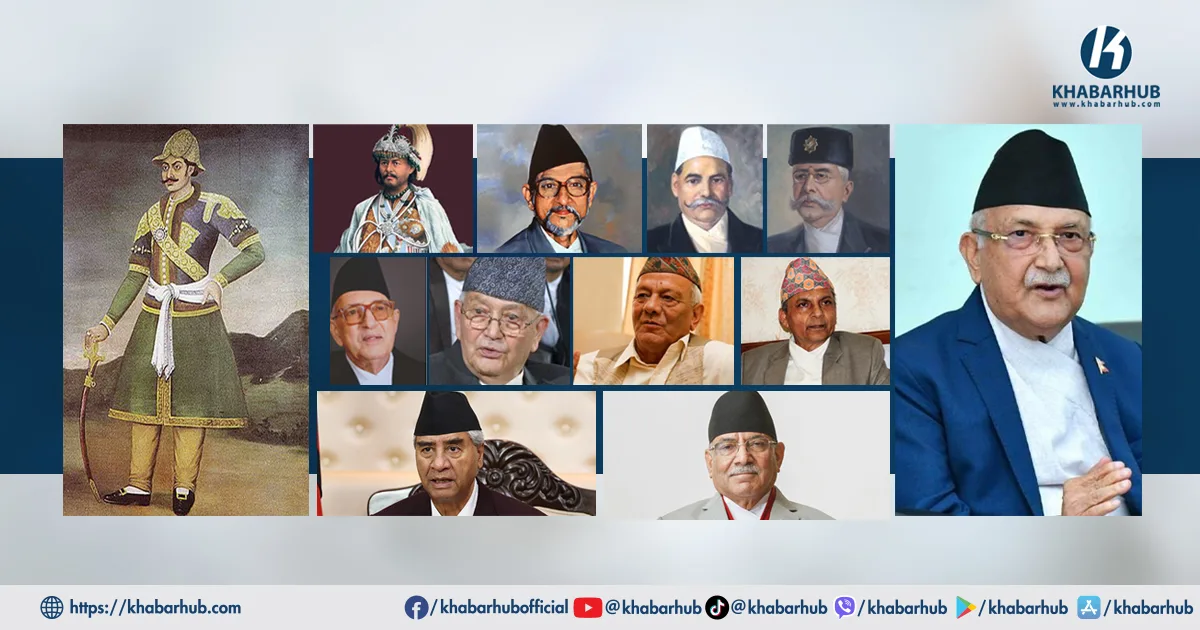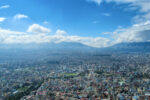KATHMANDU: CPN-UML Chairman KP Sharma Oli has been appointed as the Prime Minister of Nepal.
President Ram Chandra Paudel appointed him under Article 76 (2) of the Constitution on Sunday.
UML Chairman Oli is the 38th individual to assume the role of Prime Minister in Nepal.
However, according to records from the Office of the Prime Minister and Council of Ministers, he is recognized as the 66th Prime Minister.
In the history of Nepal’s Prime Ministers, 38 leaders have held office for a total of 63 terms.
Among them, 4 served as “Mukhtiyar” (Chief), 4 as Chairman of the Council of Ministers, and 31 as Prime Minister.
Surya Bahadur Thapa is notable for having served as both Chairman of the Council of Ministers and Prime Minister.
Similarly, Fatte Jung Shah is the only one to have held the position of “Mukhtiyar” and Prime Minister.
Alongside Thapa, the late Girija Prasad Koirala and Sher Bahadur Deuba have each held the reins of government five times on separate occasions, while Lokendra Bahadur Chand and KP Oli have each been Prime Minister four times.
Outgoing Prime Minister Pushpa Kamal Dahal ‘Prachanda’ has held office three times.
Thapa resumed his role as Prime Minister from 2023 BS to 2025 BS, and is noted in the records of the Prime Minister and Council of Ministers Office for terms from 2036 BS to 2040 BS, 2054 BS to 2054 BS, and 2060 BS to 2061 BS.
Six individuals have held the position twice, and 25 individuals have served once.
Bhimsen Thapa is historically regarded as Nepal’s first Prime Minister, serving as “Mukhtiyar” from 1863 BS to 1894 BS. After him, Pandit Ranganath Paudyal (1894-1895), Pushkar Shah (1895-1896), Ranganath Pandey (1896-1897), and Fatte Jung Shah (1897-1900) also held office as “Mukhtiyar”.
The title of “Mukhtiyar” transitioned to Prime Minister from 1900 BS, starting with Mathwarsingh Thapa, who held office from 1900 BS to 1902 BS.
Records show that Fatte Jung Shah resumed office as Prime Minister from 1902 BS to 1903 BS.
Jung Bahadur Rana, succeeding Fatte Jung Shah, served as Prime Minister from 1903 BS to 1913 BS and again from 1914 BS to 1933 BS, marking the beginning of the Rana regime that lasted 103 years.
Ten subsequent Ranas took turns as Prime Ministers alongside him.
Mohan Shumsher was the last Prime Minister of the Rana era, serving from 2005 BS to 2008 BS.
Matrika Prasad Koirala became Prime Minister following the end of the Rana regime, serving first from 2008 BS to 2009 BS and again from 2010 BS to 2011 BS.
Bishweshwar Prasad (BP) Koirala, the founder of Nepali Congress, became Nepal’s first democratically elected Prime Minister in 2016 BS.
Following the Rana regime, leaders such as Tanka Prasad Acharya, Dr. KI Singh, and Subarna Shumsher also held office.
Acharya held the reins of power from 2012 BS to 2014 BS, while Singh briefly served in 2014 BS.
Similarly, Subarna, the founding leader of Nepali Congress, governed from 2015 BS to 2016 BS, becoming the first person to hold power as the Chairman of the Council of Ministers in Nepal.
Dr. Tulsi Giri also held office twice as the Chairman of the Council of Ministers.
His first term was from 2019 BS to 2021 BS, followed by a second term spanning from 2032 BS to 2043 BS during Nepal’s one-party Panchayat system era.
Even after Nepal became a republic, an interim leader governed as the Chairman of the Cabinet.
When the first Constituent Assembly failed to complete the constitution, Chief Justice Khilraj Regmi became the first person in Nepal’s history to transition from Chief Justice to Prime Minister.
After Tulsi Giri, Surya Bahadur Thapa also served as Prime Minister while holding the position of Chairman of the Council of Ministers.
Girija Prasad Koirala emerged in Nepali parliamentary politics following the government formed after the first general election post the restoration of democracy through the people’s movement.
Initially appointed by King Mahendra Shah in 2021 BS, Thapa continued in various terms until 2061 BS, holding the record for serving as Prime Minister five times.
Thapa resumed his role as Prime Minister from 2023 BS to 2025 BS, and is noted in the records of the Prime Minister and Council of Ministers Office for terms from 2036 BS to 2040 BS, 2054 BS to 2054 BS, and 2060 BS to 2061 BS.
Kirtinidhi Bista succeeded Thapa in the Panchayat system, serving his first term as Prime Minister in 2025 BS.
He continued with a second term from 2028 BS to 2030 BS, and a third term from 2034 BS to 2036 BS.
Pushpa Kamal Dahal ‘Prachanda’ served as Prime Minister three times.
After leading a decade-long armed conflict, he was first appointed Prime Minister in 2065 BS following the peace process.
Prachanda assumed office again in 2073 BS, but resigned on 2074 BS, amidst controversy involving Chief of Army Staff Rukmangat Katuwal.
His third term ended on 2079 BS, after failing to secure a vote of confidence in the House of Representatives.
Nagendra Prasad Rijal and Krishna Prasad Bhattarai, like Fatte Jung Shah, Jung Bahadur Rana, and Matrika Prasad Koirala, served as Prime Minister twice.
Rijal held office in 2030 BS and 2042 BS under the Panchayat system.
Bhattarai, one of the founding leaders of Nepali Congress, first became Prime Minister during the interim government formed in 2047 BS after the collapse of the Panchayati system.
He was re-elected after the 2056 BS general election, but faced internal party strife which shortened his tenure.
Manmohan Adhikari, Madhav Kumar Nepal, Jhalanath Khanal, Dr. Baburam Bhattarai, and Sushil Koirala have also led Nepal as Prime Ministers at different times:
Lokendra Bahadur Chand was Prime Minister from 2046 BS to 2047 BS before handing over leadership to Bhattarai in 2047 BS.
Initially nominated by King Birendra Shah, Chand first served as Prime Minister in 2040 BS for a two-year term.
Chand continued his political career after democracy was established, serving as Prime Minister in 2053 BS and 2059 BS.
Despite challenges, Prime Minister Chand managed to govern for nearly a year.
Meanwhile, Marichman Shrestha was a leader during the Panchayat era who served as Prime Minister once.
He held office for three years under King Birendra Shah, from 2043 BS to 2046 BS.
Girija Prasad Koirala emerged in Nepali parliamentary politics following the government formed after the first general election post the restoration of democracy through the people’s movement.
Koirala served as Prime Minister from 2048 BS to 2051 BS, marking his first term. He subsequently held the office for four additional terms: in 2054 BS, 2055 BS, 2056 BS, and 2063 BS, making him the second leader to serve as Prime Minister five times.
Sher Bahadur Deuba, President of Nepali Congress, is the third leader to have held the position of Prime Minister five times.
His first term began in 2052 BS, followed by subsequent terms in 2058 BS, 2061 BS, 2070, and 2078 BS.
Manmohan Adhikari, Madhav Kumar Nepal, Jhalanath Khanal, Dr. Baburam Bhattarai, and Sushil Koirala have also led Nepal as Prime Ministers at different times:
Adhikari assumed office in 2051 BS, Nepal in 2066 BS, Khanal in 2067 BS, Bhattarai in 2068 BS, and Koirala in 2070 BS.
Under Sushil Koirala’s leadership, Nepal’s constitution was promulgated in 2072 BS (2015).









Comment